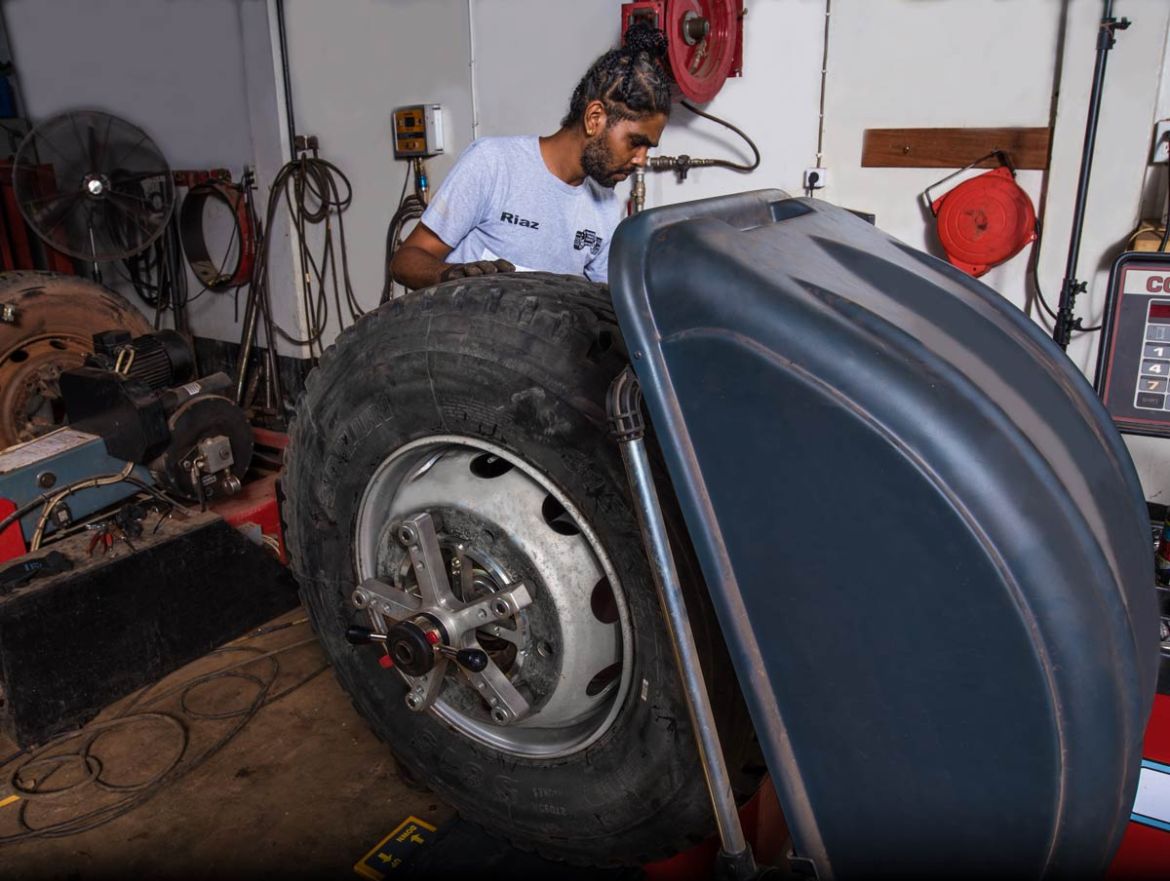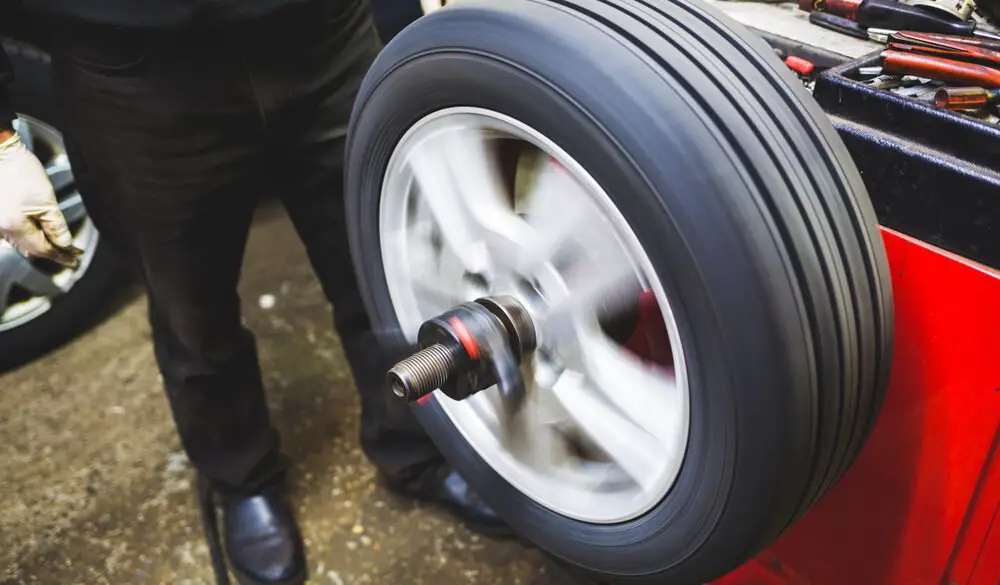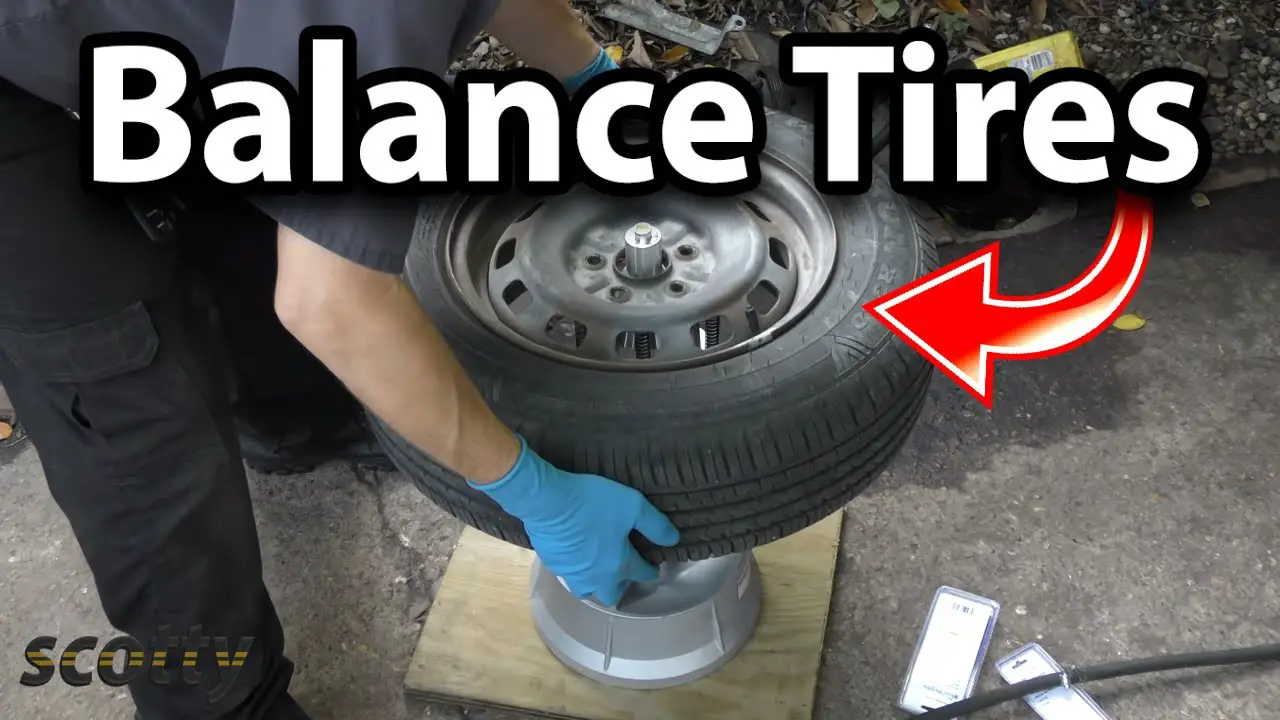What Is Wheel Alignment
Wheel alignment refers to an adjustment of a car’s suspension the system that connects a vehicle to its wheels. It’s not an adjustment of the tires or wheels themselves.
Alignment keeps your car from veering to the right or left. It also can improve the handling of your vehicle and stop unusual on-the-road vibrations.
Is It Okay To Drive A Car With Unbalanced Tires
Unbalanced car tires can cause damage to different parts of your vehicle. For example, driving with tires that arent properly balanced puts undue stress on your shocks, bearings, and wheel assembly. Increased fuel costs. Driving on tires out of balance may cause your fuel costs to rise.
Do My Wheels Really Need To Be Balanced Yes Heres Why
Many people make the mistake of ignoring the necessity of a wheel balance. They dont think about it until the wheels are out of balance and their car, truck, or SUV vibrates and makes annoying road noise. Its important to have your wheels rotated and balanced every 6,000 miles. Here are some things about wheel balancing you might not have know per Stringer Auto Repair, LLC.
Read Also: Firestone Ac Recharge Cost
Tire & Wheel Balancing Service
During a tire mounting and balancing service, a service technician will remove the existing tires and wheels, spin the wheels using state-of-the-art tire balancing equipment then work to find any potential imbalance in the tires. Balancing your tires will help create a smoother ride and reduce tire wear.
When Balancing Tires Do You Need To Balance Them

No, you dont really need to balance your tires when rotating them. It can be a good idea, though. Just as having an alignment done when you replace tires, it can extend the tread life. If you dont feel any vibration around 55-60mph and the tread appears evenly worn, you can probably forgo balancing.
You May Like: What Rental Car Places Take Debit Cards
Breaking Down The Costs Of Tire Rotation And Balance
Wheel balancing is a much cheaper service than rotation and you can expect to pay anything between $10 and $50 per tire.
Tire rotation can cost you anything from $20 to $200 and will depend on what kind of equipment is required to conduct the service, how old your car is, which city you live in, and the prices set by the company switching them for you.
Many garages and auto-shops offer a packaged rate with all rotation, balancing, and alignment services combined. Sometimes, if you have bought new tires from a company, they will offer to balance and rotate them for free for the first few years or till you reach a certain mileage limit. Its best to work out the best possible deal with your garage from the beginning to avoid unexpected costs at a later stage.
You might want to compare rates and packages from a number of well-rated garages before making a decision to see which best suits your budget and offers exactly what you require.
Balance Tires: The Basics
First thing’s first: let’s learn a little bit more about how tire balancing services are performed. For the most part, tire balance services help your vehicle churn out optimal functioning.
Once the date of your appointment has arrived, your trusted mechanic will analyze the performance of your tires by doing the following:
- Removing your wheels and tires
- Mounting each wheel on a balancing machine
- Spinning the tires to ensure that the tires are balanced around the axles
- Locating the tire imbalance
- Addressing the balance issue by using a lead weight
- Remounting your wheels and tires to your vehicle
In addition to these services, your highly qualified technician will gladly offer up information about anything else they find while balancing your tires. That way, you’ll leave your repair shop inside a car that’s ready to surge down the road with uncompromised power.
Recommended Reading: Columbo Car Model
Car Suv And Truck Tire Balance
Wheel alignment and wheel balancing are two separate yet equally important components of a smooth and efficient ride. Proper tire balancing keeps your tires rotating while minimizing vibrations from the road. The symptoms of an unbalanced wheel include:
- Cupped or scalloped wear patterns on the tires
- Vibration in the floorboard or the seat at certain speeds
- Vibration in the steering wheel at certain speeds
Vibrations such as those listed above typically occur at highway speeds such as 45 mph or more. When one section of the tire is heavier than the other, then tire unbalancing is inevitable. As little as one ounce of tire imbalance at the front of your vehicle is enough to result in a vibration that can be felt through the steering wheel when going approximately 60 mph.
Do All 4 Tires Need To Be Balanced
If it is not, he will attach small lead weights to the rim of the wheel to ensure that they are balanced. Most manufacturers recommend that all four tires should be rotated and balanced approximately every seven thousand miles. Typically, tread wears away quicker on the front tires than on the back tires.
Read Also: Typical Car Sales Commission
When Should I Balance My Tires
People often notice unbalanced tires when they are on the front wheels because the vibrations are transferred through the steering wheel to the drivers hands. These same vibrations can be in the rear as well but arent as noticeable. It is recommended you balance every new tire once it is installed, front or back.
Most often, a balance is done when you get a wheel alignment, since many of the symptoms are the same. Between proper balance and alignment, most serious vibration issues can be fixed.
How To Balance A Tire With A Machine
For tires that arent balanced, mechanics begin by putting your wheels one by one on a balancing machine. As the units spin, this machine will be measuring vibration and identifying any stiffer spots. From these results, mechanics will know whether weight is balanced and, if not, where there is an imbalance. He will then use zinc, aluminum, or steel elements on stiffer sports to fix misbalancing issues. Depending on the problem, he may rotate your tires on the wheels to line up heavier spots.
Recommended Reading: Car Squeaking When Driving But Stops When Braking
How Are Tires Balanced
There are two methods for tire balancing performed at your local garage static balance and dynamic balance.
1. Static balancing
If there is only a slight imbalance to the tire, static balancing is the appropriate technique and is relatively easy to do the wheel and tire assembly is placed onto a vertical supporting device with a spindle or equivalent to measure balancing on one axis. The heavier side will lean lower to the ground than the lighter side once identified, the mechanic will place a small weight measuring fractions of an ounce 180 degrees across the plane of the tire, onto the flange of the wheel rim, until the balance is restored.
2. Dynamic balancing
For more complex cases of tire imbalance, dynamic balancing is a technique using spinning computer balancers to measure the tire on all three axes. The mechanic places a fully assembled wheel and tire on a machine and rotates it at speed ranging from 16-25 km/h to 88-96 km/h . As it spins, the sensors of the machine capture every single weight imperfection.
With the analysis complete, the computer then specifies how much weight and where the mechanic should apply to balance the tire. The small weights either clip-on or adhesive weights are added to both the inner and outer sides of the wheel rim, to provide the highest precision and balance.
Balanced Tires Reveal Other Issues

If youre faithful about keeping your wheels balanced yet still feel pulling and road vibration, you might have something else going on with your vehicles suspension. For example, if you feel every bump on the road yet you have brand new, balanced tires, your shocks and struts may be worn. If your vehicle is difficult to control, it could be the wheel alignment or an issue with your steering system.
Stringer Auto Repair, LLC, in Johnstown, OH, offers our customer wheel balancing and alignment services. Wed be happy to check your tires and wheels and rotate, balance, and align them if necessary. You can set up an appointment by calling us today. We are a full-service automotive repair and preventative maintenance shop, so call us today for your automotive needs.
Also Check: Club Car Year Identification
What Are The Signs That Your Tires Needs Balancing
Uneven tire wear and vibration in your steering wheel, floorboard, or seat can signal it’s time for tire balancing. You may also want to have your tires balanced during a tire rotation, after a flat tire repair, or as part of your scheduled maintenance.
Interestingly, the part of your car that trembles can indicate whether the front or back wheels need balancing. If it’s in the steering wheel, its likely your front tires. If it’s in the seats, the imbalance is in the back wheels.
Tires can become out of balance because of uneven tire wear or the loss of a wheel weight because a rim hits a curb or pothole. If you leave your car parked for extended periods without moving it, the tires might develop flat spots that cause imbalances.
Do Unbalanced Tires Make Noise
The unbalanced tread depths cause tires to emit loud noises while driving. Usually, youll hear sounds caused by uneven wear coming from one tire. This will cause irregular tire movement and make the sounds coming from the air chamber louder. A bad wheel bearing is one of the more serious issues that cause tire noise.
You May Like: How Do I Transfer An Electronic Title In Florida
Keeping You Safer Behind The Wheel
When your tires are out of balance, the safety of yourself and your passengers is compromised. You may not be able to stop properly, and you could even lose control if you need to swerve to avoid an oncoming vehicle.
It is not always easy to tell if your tires are out of balance, but there are a few telltale signs and symptoms. If you notice a shaking or shimmying as you drive, or if your vehicle pulls to one side, you may need to have your tires balanced. If you suspect your tires are not properly balanced, just stop by Motor Works Auto to have it checked. We will use our state-of-the-art equipment to check your tires, make the necessary adjustments and get you back on the road safely.
Tire Balancing: What You Need To Know
One small thing that can cause early tire and suspension wear is an out-of-balance tire. Though the tire balancing procedure may seem minor, it is a critical procedure. If tires dont have regular balancing, then your cars handling and even safety may worsen. Discover more about tire balancing, what it does, and signs you need to have your tires re-balanced.
Why Do Tires Need Balancing?
Tires and wheels do not come from the manufacturer in perfect condition and ready to go. Though they may seem uniform to the eye, tires and wheels often have variations in weight throughout their structure. Normal wear and tear can also change your wheel and tires balance. When your wheels are not balanced, your tires will not spin smoothly. This affects the way your vehicle handles.
How Is Balancing Done?
Tires are balanced after they are mounted on the wheel. Modern tire shops use a computerized spin balancing machine. The tire goes on the machine and spins at highway speeds. The computer reads where the tire is unbalanced and indicates where weights should be placed on the wheel. The technician places thin metal pieces on the rim to counterbalance heavy spots. Then, the technician spins the wheel again to ensure it has proper0 balance.
What Are the Signs of Out-of-Balance Tires?
Only a small amount of imbalance is enough to disrupt how your car feels and handles. Discover some of the signs that you need to balance your tires.
Strange Vibrations
Unusual Tread Wear
Recommended Reading: Fastest Jdm Car Forza Horizon 4
Reasons To Balance Tires
When it comes to our cars, it can feel like were always looking for ways to save money. This often means avoiding or putting off services we know we shouldnt. Among those services is balancing your tires.
It turns out there are all kinds of reasons why you should balance your tires. In addition to keeping you safe, balancing your tires can give you a smoother ride while also extending the life of your car. Here are five reasons why you need to balance your tires, and what you need to know to get the job done right.
Olson Tire And Auto Service Tire Balancing In Wausau Wi
Stop at Olson Tire And Auto Service today to have your vehicle evaluated for potential tire balancing problems! Our tire experts are here to assist you in the Wausau, WI and surrounding areas. Olson Tire And Auto Service is your number one source for new tires, tire installation, and tire services in Wausau, WI.
Recommended Reading: Paper Title Florida
Tire Wear Affects Wheel Balance
Even though the wheels are balanced after your new tires are put on they dont stay balanced forever. The wheel balance is thrown off as your tire tread wears down. Tire pressure can also affect wheel balance, which is why we recommend you check your tire pressure frequently. Having the wheels balanced regularly ensures they remain balanced throughout the little changes in your tires.
Different Types Of Imbalance

There are two different types of tire imbalance that can occur they are static and dynamic imbalances.
Static imbalance occurs when a heavy or light section in the tire prevents the tire from rotating evenly. This will cause an up and down motion, or hop.
The following image demonstrates a static imbalance:
A dynamic imbalance occurs when there is an unequal amount of weight on either one or both sides of the wheels lateral centerline. This creates a side to side motion, or wobble.
The following image demonstrates a dynamic imbalance:
You May Like: Who Accepts Car Care One Card
How Can You Tell When Its Time For A Balance
Unlike some vehicle maintenance issues that tend to hide until the problem gets out of hand, youll know when its time to get a tire balance or at least a check-up. An imbalance in the tire will cause it to wobble and vibrate as the wheel starts to rotate. The faster the rotation, the more intense the vibration. If you feel a vibration in the steering wheel, thats probably related to an issue with the front tires balance, but a vibration that can be felt in your seat likely indicates an issue with rear-tire balance.
It doesn’t take much to end up with an out-of-balance wheel and tire.
Your Wheels Need Regular Balancing
Wheel balancing isnt optional its necessary. Once new tires are put on your vehicle, they need to be balanced to your car, truck, or SUVs wheels. Your wheels are an assembly with many parts. Tire manufacturers balance tires during the production process, but the balancing must be fine-tuned once the tires are placed on the wheels. As such, wheel assembly balancing isnt optional.
Recommended Reading: What Commission Do Car Salesmen Make
How Often Should You Have Your Tired Balanced
Usually, it’s a good idea to have your car’s tires balanced as part of its general upkeep and maintenance. Ideally, you’ll have tire balancing performed every six months or 5,000 miles, or as recommended by your vehicle’s owners manual. Often, people combine tire balancing with getting a tire change or tire rotation.
If it’s been some time since you had the tires balanced, or if you’ve never had the tires balanced, they might give you a sign or two that it’s time to see a technician. If you experience any of the following, it’s a good idea to bring your car in for tire balancing:
- Vibration in the steering wheel, seats of the car, or the floor of the car
- Visible signs of uneven wear on the tires or tire treads.
- Missing tire weights on the rims of the wheels.
You’ll also want to have the tires balanced any time you make a change to the tires or wheels. For example, if you get a flat and bring it in for repair, that’s an ideal time also balance the tires.
Although every 5,000 miles is often the standard recommendation, if you drive on rough or unpaved roads a lot, you might need to bring your car in for a tire change and balancing more frequently.
How Do I Know When My Tires Need To Be Balanced
As with tire rotation, you want to have your tires balanced regularly and before any noticeable warning signs appear.
If you have not regularly balanced your tires, you want to check for any wheel vibration in the steering wheel. You can also have professional maintenance and inspection performed on your vehicle at least once a year that will check the wear of your tires among other things.
You May Like: Transfer Car Title Arizona
Q Ok Then How Often Do I Need A Tire Balance
A. You should have your tires checked at each oil change, which is generally every 5,000 to 15,000 miles, to avoid letting a problem fester that could cause wear issues or safety problems with your vehicle. This doesnt mean youll need a balance every time. It just means that you should be keeping on top of whats happening with your tires.
